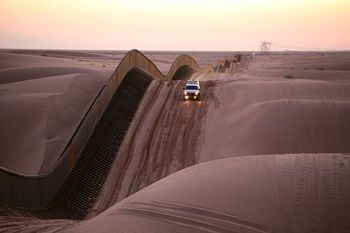
La página que intenta visitar sólo está disponible en inglés. ¡Disculpa!
The page you are about to visit is currently only available in English. Sorry!


(United States Border Patrol at Algodones Sand Dunes, California. By Department of Homeland Security)
Surrounded by controversy, the fences lining the U.S.–Mexico border were constructed as obstacles to human travel. But these fences also threaten the animals whose homes happen to fall on arbitrary state lines. The barriers, which cover about 570 miles in total, fragment populations and make it harder for wildlife to move throughout natural ranges. Now, scores of species are at greater risk of global extinction because of the walls, says a new study.
The border block is extensive: It includes 370 miles worth of fences that are supposed to be impenetrable to humans. Most are fifteen feet tall and buried three feet in the ground. More fences are in the works. Twenty-seven species face a higher risk of global extinction due to the barriers, found researchers from the University of Texas at Austin. The threatened list includes the endangered Arroyo toad and the black-spotted newt.
The study only examined amphibians, reptiles, and mammals that don’t fly, but add 23 more species, which face local extinction, to the list above and there’s a definitive danger to our wildlife. The results were published in the journal Diversity and Distributions.
Constructing partitions within a population can have negative impacts, including a loss of genetic diversity and an increased risk of extinction. The fences, which have very small openings if any, make it hard for animals to move over their natural ranges. Since an animal is more likely to mate with its counterpart if it lives on the same side of the fence than if it lies on the other side, the mating pool is smaller and genetic variability is lost. Genetic variability is important because it gives a population flexibility to adapt to changing environments.
Small populations also disappear faster than large populations, so when fences bisect a species’ domain, there is a greater chance that it will go extinct, locally or globally.
The team of researchers estimated the risk to species living around the border by looking at range maps and comparing the location of border fences that are in place or planned by the U.S. Customs and Border Protection as of January 1, 2011. They also included areas with a high “Human Footprint Index,” which measures the level of human impact on surrounding ecosystems.
The fences aren’t the only barriers to wildlife migration at the border. Fences have to be constructed, and with construction comes machinery, roads, night lighting, plant removal, and other human disturbances. Also, now movement is funneled to open sections of the border, which means that even areas without fences are subject to habitat destruction.
The scientists are also concerned that the walls will inhibit northward movement as the earth warms and species attempt to relocate.
The lands along the border are incredibly diverse. There are seven ecoregions in total. According to the study, amphibian species found at the border make up 17 percent of amphibian species within the entire U.S., border reptiles make up 49 percent of the U.S. reptilian species and border mammals comprise 39 percent of the U.S. mammalian fauna.
Wall construction has occurred rapidly. One reason is because fences built along the U.S.–Mexico border are exempt from environmental regulations. Under the REAL ID Act of 2005, the Secretary of the Department of Homeland Security can build walls on the border without any review.
To protect our continent’s wildlife, the authors of the study stress the need to increase border permeability. Others may object.
---------------------------------
Also Read:
Paradise Lost: The Rio Grande Valley in south Texas is one of this nation’s most biologically rich areas. Walls do little to stop illegal immigration, do a lot to harm wildlife, and effectively cede much of this land to Mexico.
Border Jumpers: The pygmy owl, jaguar, Sonoran pronghorn and ocelot live at the border.
Welcome Back: A sanctuary, sealed off by the border wall, reopens its doors.
Dead End: As the bitter debate over illegal immigration to the US rages, the first of many planned barriers, a 295-mile-long wall, is being built through a remote desert corridor along the U.S.–Mexico border.